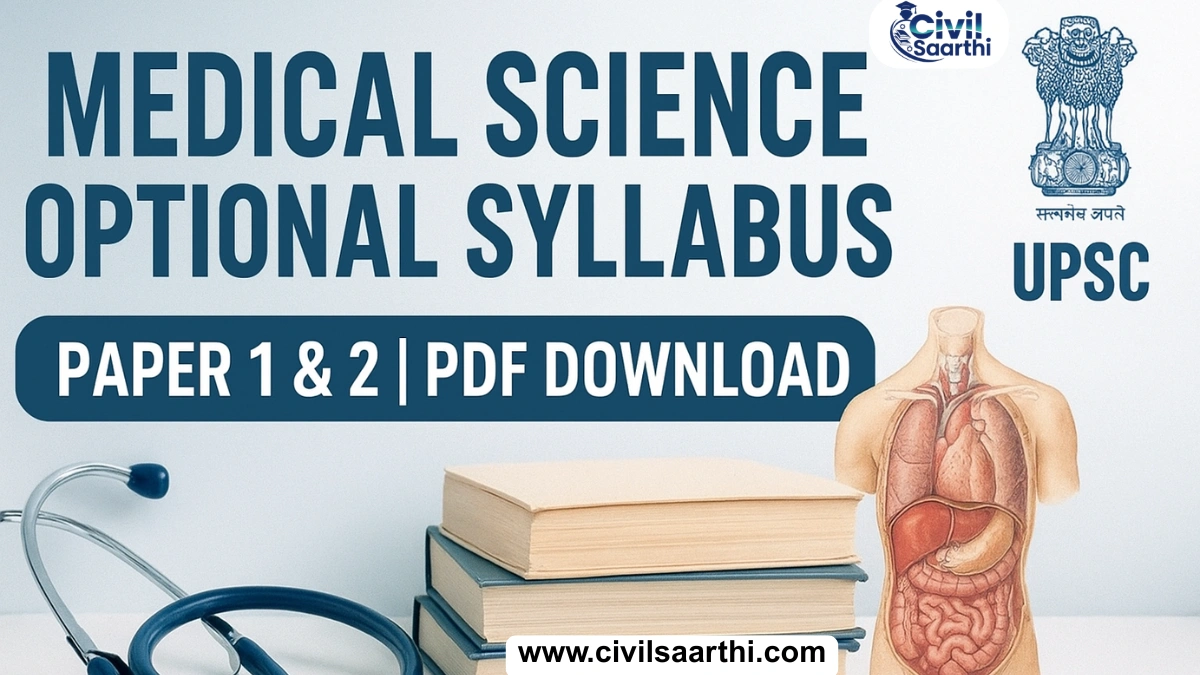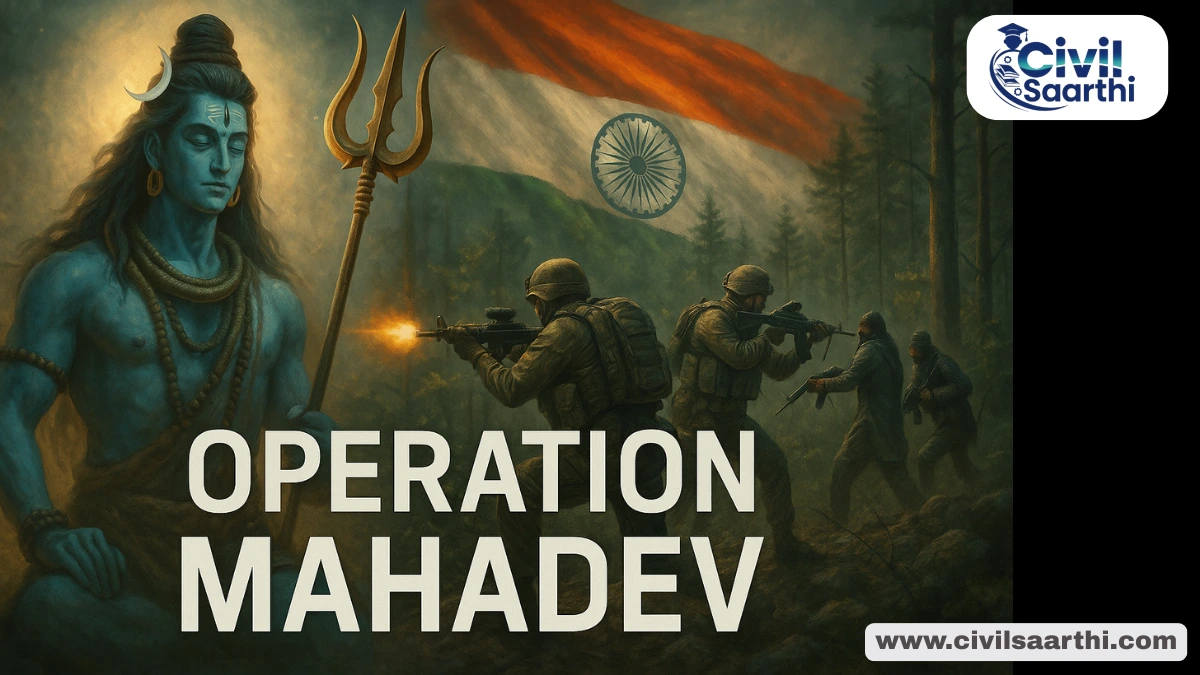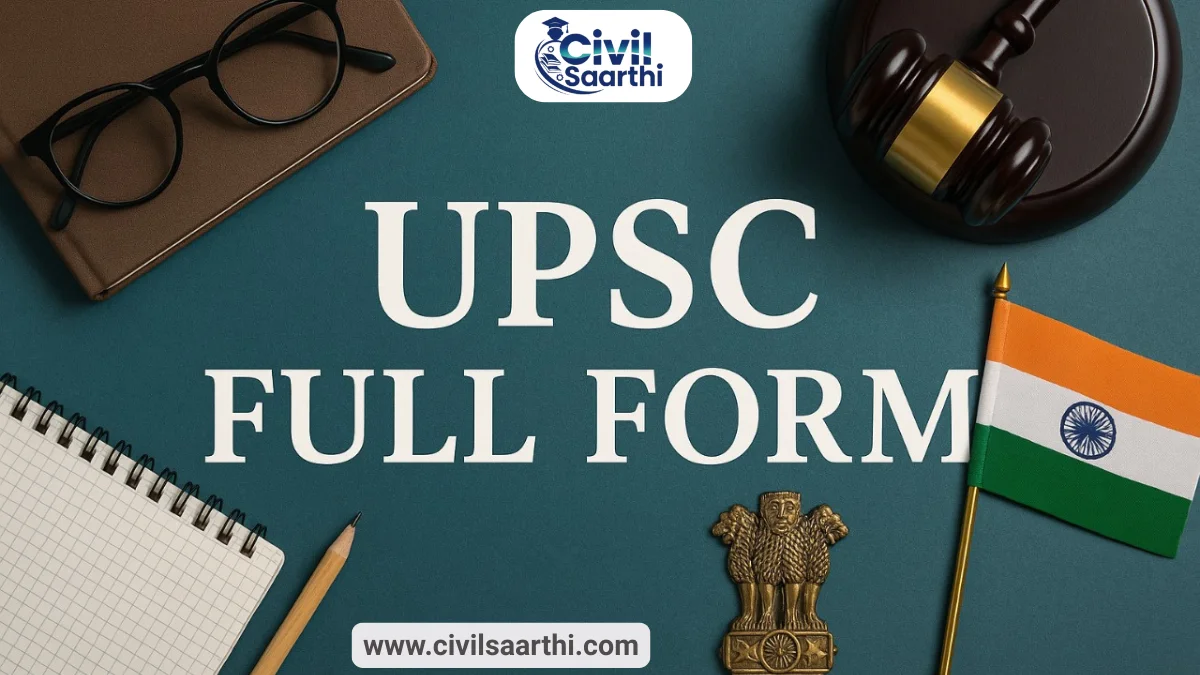The UPSC Medical Science Optional Syllabus 2025 is a well-structured and scoring choice for medical graduates, especially those with an MBBS background. It closely follows the standard medical curriculum, covering both theoretical and clinical subjects across two papers. With its focused and static nature, it allows candidates to utilize their academic strengths effectively in the UPSC Mains Examination. The link to download the UPSC Medical Science Optional Syllabus 2025 PDF has been shared below in the article.
UPSC Medical Science Optional Syllabus 2025
The UPSC Medical Science Optional Syllabus 2025 consists of two papers, each carrying 250 marks, summing up to 500 marks. The syllabus closely aligns with the MBBS course content, ensuring that medical graduates can rely on their academic knowledge to prepare efficiently. With a clear conceptual understanding and consistent revision, the UPSC Medical Science Optional Syllabus 2025 can be mastered effectively.
UPSC Medical Science Optional Syllabus PDF Download
The UPSC Medical Science Optional Syllabus covers the core areas of MBBS subjects like Anatomy, Physiology, Pathology, Medicine, Surgery, and Community Medicine. It is designed to test applied knowledge and conceptual clarity. Aspirants with a medical background can benefit by aligning their preparation with standard textbooks. Download the complete syllabus PDF for Paper 1 and Paper 2 from the link provided below.
📥 Download UPSC Medical Science Optional Syllabus PDF (Paper 1 & 2)
Also Read: UPSC Medical Science Optional Paper 2025
UPSC Medical Science Optional Syllabus for Paper 1 Official
1. Human Anatomy :
Applied anatomy including blood and nerve supply of upper and lower limbs and joints of shoulder, hip and knee.
Gross anatomy, blood supply and lymphatic drainage of tongue, thyroid, mammary gland, stomach, liver, prostate, gonads and uterus.
Applied anatomy of diaphragm, perineum and inguinal region.
Clinical anatomy of kidney, urinary bladder, uterine tubes, vas deferens.
Embryology : Placenta and placental barrier. Development of heart, gut, kidney. uterus, ovary, testis and their common congenital abnormalities.
Central and Peripheral Autonomic Nervous System : Gross and clinical anatomy of ventricles of brain, circulation of cerebrospinal fluid; Neural pathways and lesions of cutaneous sensations, hearing and vision; Cranial nerves distribution and clinical significance; Components of autonomic nervous system.
2. Human Physiology :
Conduction and transmission of impulse, mechanism of contraction, neuromuscular transmission, reflexes, control of equilibrium, posture and muscle tone, descending pathways, functions of cerebellum, basal ganglia, Physiology of sleep and consciousness.
Endocrine System : Mechanism of action of hormones; formation, secretion, transport, metabolism, function and regulation of secretion of pancreas and pituitary gland.
Physiology of Reproductive System : Pregnancy menstrual cycle, lactation, pregnancy.
Blood : Development, regulation and fate of blood cells.
Cardio-vascular,cardiac output, blood pressure, regulation of cardiovascular functions.
3. Biochemistry :
Organ function tests – liver, kidney, thyroid Protein synthesis.
Vitamins and minerals.
Restriction fragment length.
polymorphism (RFLP Polymerase chain reaction (PCR).
Radio-immunoassays (RIA).
4. Pathology :
Inflammation and repair, disturbances of growth and cancer, Pathogenesis and histopathology of rheumatic and ischaemic heart disease and diabetes mellitus. Differentiation between benign, malignant, primary and metastatic malignancies, Pathogenesis and histopathology of bronchogenic carcinoma, carcinoma breast, oral cancer, cancer cervix, leukemia, Etiology, pathogenesis and histopathology of—cirrhosis liver, glomerulonephritis, tuberculosis, acute osteomyelitis.
5. Microbiology :
Humoral and cell mediated immunity.
Diseases caused by and laboratory diagnosis of —
* Meningococcus, Saimonella
* Shigella, Herpes, Dengue, Polio
* HIV/AIDS, Malaria, E. Histolytica, Giardia
* Candida, Cryptococcus, Aspergillus.
6. Pharmacology :
Mechanism of action and side effects of the following drugs :
* Antipyretics and analgesics, Antibiotics,
* Antimalaria, Antikala-azar, Antidiabetics,
* Antihypertensive, Antidiuretics, General and cardiac vasodilators, Antiviral, Antiparasitic, Antifungal, Immunosuppressants,
* Anticancer.
7. Forensic Medicine and Toxicology
Forensic examination of injuries and wounds; Examination of blood and seminal stains; Poisoning, sedative
overdose, hanging, drowning, burns, DNA and finger print study.
UPSC Medical Science Optional Syllabus for Paper 2
1. General Medicine
Etiology, clinical features, diagnosis and principles of management (including prevention) of—Typhoid,
Rabies, AIDS, Dengue, Kala-azar, Japanese Encephalitis.
Etiology, clinical features, diagnosis and principles of management of :
Ischaemic heart disease, pulmonary embolism.
Bronchial asthma.
Pleural effusion, tuberculosis, Malabsorption syndromes; acid peptic diseases, Viral hepatitis and cirrhosis of liver.
Glomerulonephritis and pyelonephritis, renal failure, nephrotic syndrome, renovascular hypertension, complications of diabetes mellitus, coagulation disorders, leukaemia, Hypo and hyper thyrodism, meningitis and encephalitis.
Imaging in medical problems, ultrasound, echo- cardiogram, CT scan, MRI.
Anxiety and Depressive Psychosis and schizophrenia and ECT.
2. Paediatrics
Immunization, Baby friendly hospital, congenital cyanotic heart disease, respiratory distress syndrome, broncho— pneumonias, kernicterus. IMNCI classification and management, PEM grading and management.
ARI and Diarrhea of under five and their management.
3. Dermatology
Psoriasis, Allergic dermatitis, scabies, eczema, vitiligo, Stevan Johnson’s syndrome, Lichen Planus.
4. General Surgery
Clinical features, causes, diagnosis and principles of management of cleft palate, harelip.
Laryngeal tumour, oral and esophageal tumours.
Peripheral arterial diseases, varicose veins, coarctation of aorta.
Tumours of Thyroid, Adrenal, Glands.
Abscess cancer, fibroadenoma and adenosis of breast.
Bleeding peptic ulcer, tuberculosis of bowel, ulcerative colitis, cancer stomach.
Renal mass, cancer prostatie.
Haemothorax, stones of Gall bladder, Kidney, Ureter and Urinary Bladder.
Management of surgical conditions of Rectum, Anus and Anal canal, Gall bladder and Bile ducts.
Splenomegaly, cholecystitis, portal hypertension, liver abscess, peritonitis, carcinoma head of pancreas.
Fractures of spine, Colles’ fracture and bone tumors.
Endoscopy.
Laprascopic Surgery.
5. Obstetrics and Gynaecology including Family Planning
Diagnosis of pregnancy.
Labour management, complications of 3rd stage, Antepartum and postpartum hemorrhage, resuscitation of the newborn, Management of abnormal life and difficult labour. Management of small for date or premature newborn.
Diagnosis and management of anemia. Preeclampsia and Toxaemias of pregnancy, Management of Postmenopausal Syndrome.
Intra-uterine devices, pills, tubectomy and vasectomy. Medical termination of pregnancy including legal
aspects.
Cancer cervix.
Leucorrhoea, pelvic pain; infertility, dysfunctional uterine bleeding (DUB), amenorrhoea, Fibroid and prolapse of uterus.
6. Community Medicine (Preventive and Social Medicine)
Principles, methods approach and measurements of Epidemiology.
Nutrition, nutritional diseases/diorders and Nutrition Programmes. Health information Collection, Analysis and Presentation.
Objectives, components and critical analysis of National programmes for control/eradication of :
Malaria, Kala-azar, Filaria and Tuberculosis,
HIV/AIDS, STDs and Dengue.
Critical appraisal of Health care delivery system.
Health management and administration; Techniques, Tools, Programme Implementation and Evaluation.
Objectives, Components, Goals and Status of Reproductive and Child Health, National Rural Health Mission and Millennium Development Goals.
Management of hospital and industrial waste.
UPSC Medical Science Optional Preparation Strategy
To excel in the UPSC Medical Science Optional Syllabus 2025, candidates must design a well-planned preparation approach. It’s important to combine theoretical studies with answer writing practice and regular revision to score well. Here is the preparation strategy for the UPSC Medical Science Optional Syllabus 2025:
- Start with Standard Books: Focus on MBBS-level standard textbooks for both Paper I and Paper II.
- Make Concise Notes: Prepare short notes for revision, especially for high-weightage topics.
- Practice Diagrams and Flowcharts: Use them frequently in answers to enhance presentation.
- Previous Year Papers: Solve the last 10 years’ papers to understand the trend and structure.
- Join Test Series: Opt for a test series to evaluate and improve your answer writing.
Medical Science Optional UPSC Books
Medical Science Optional in UPSC requires a strong foundation in standard MBBS textbooks along with concise reference materials for revision. Choosing the right books helps cover the vast syllabus systematically. Here is a list of Medical Science Optional UPSC Books.
| Paper | Subject/Area | Recommended Books/Authors |
|---|---|---|
| Paper 1 | Anatomy | B.D. Chaurasia (Human Anatomy), Inderbir Singh’s Anatomy |
| Physiology | Guyton & Hall (Textbook of Medical Physiology), Ganong’s Review of Medical Physiology | |
| Biochemistry | Harper’s Illustrated Biochemistry, Lippincott’s Biochemistry | |
| Pathology | Robbins & Cotran Pathologic Basis of Disease, Harsh Mohan (Textbook of Pathology) | |
| Microbiology | Ananthanarayan & Paniker’s Textbook of Microbiology, Jawetz Medical Microbiology | |
| Pharmacology | K.D. Tripathi (Essentials of Medical Pharmacology), Goodman & Gilman’s Pharmacological Basis of Therapeutics | |
| Forensic Medicine | Reddy’s Essentials of Forensic Medicine & Toxicology | |
| Paper 2 | Medicine | Harrison’s Principles of Internal Medicine, API Textbook of Medicine |
| Surgery | S. Das (A Manual on Clinical Surgery), Bailey & Love’s Short Practice of Surgery | |
| Obstetrics & Gynecology | D.C. Dutta’s Textbook of Obstetrics, Shaw’s Textbook of Gynaecology | |
| Pediatrics | O.P. Ghai’s Essential Pediatrics, Nelson Textbook of Pediatrics | |
| ENT | Dhingra’s Diseases of Ear, Nose & Throat | |
| Ophthalmology | Parsons’ Diseases of the Eye, Khurana’s Comprehensive Ophthalmology | |
| Psychiatry | A Short Textbook of Psychiatry – Niraj Ahuja | |
| Dermatology | S.R. Bhatia’s Concise Dermatology, IADVL Textbook of Dermatology | |
| Community Medicine | Park’s Textbook of Preventive and Social Medicine |
UPSC Medical Science Optional Syllabus 2025 FAQs
Who should opt for the UPSC Medical Science Optional Syllabus 2025?
Candidates with an MBBS background or current medical students will benefit the most from the UPSC Medical Science Optional Syllabus 2025, due to overlap with their academic studies.
Is the UPSC Medical Science Optional Syllabus 2025 scoring?
Yes, the UPSC Medical Science Optional Syllabus 2025 is considered scoring for those who are thorough with clinical concepts and good at structured answer writing.
How much time is required to prepare for UPSC Medical Science Optional Syllabus 2025?
Ideally, 4–5 months of dedicated preparation is sufficient for the UPSC Medical Science Optional Syllabus 2025, if the aspirant has a medical background.
Do I need coaching for UPSC Medical Science Optional Syllabus 2025?
Not necessarily. With standard books, past papers, and optional test series, one can prepare for the UPSC Medical Science Optional Syllabus 2025 through self-study.
Are diagrams necessary in answers for UPSC Medical Science Optional Syllabus 2025?
Yes. Diagrams, flowcharts, and labeled structures help fetch better marks in the UPSC Medical Science Optional Syllabus 2025 answers.
How should I revise the UPSC Medical Science Optional Syllabus 2025 before the exam?
Focus on your short notes, previously asked questions, and important diagrams for quick revision of the UPSC Medical Science Optional Syllabus 2025.
Can a non-medical background student opt for UPSC Medical Science Optional Syllabus 2025?
It’s not advisable. The UPSC Medical Science Optional Syllabus 2025 is deeply rooted in MBBS-level concepts and clinical knowledge, which are tough to acquire without formal education.







